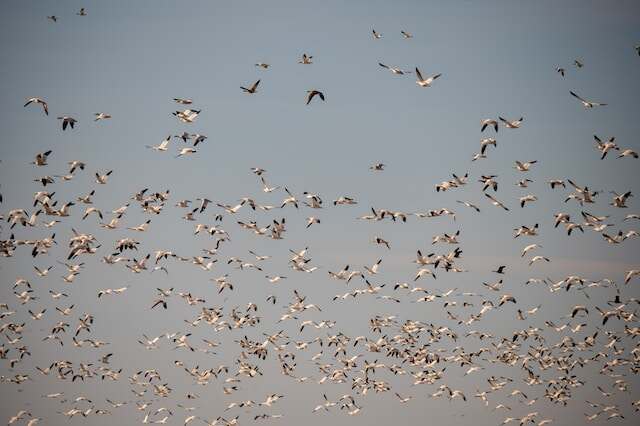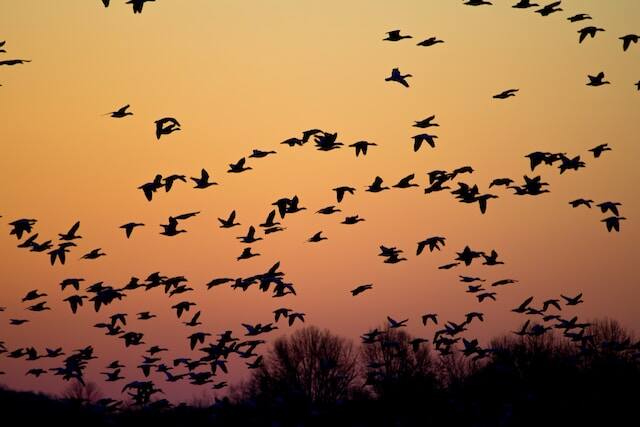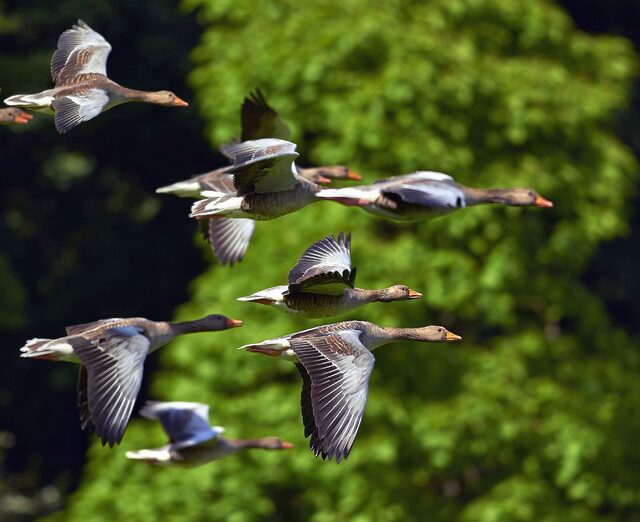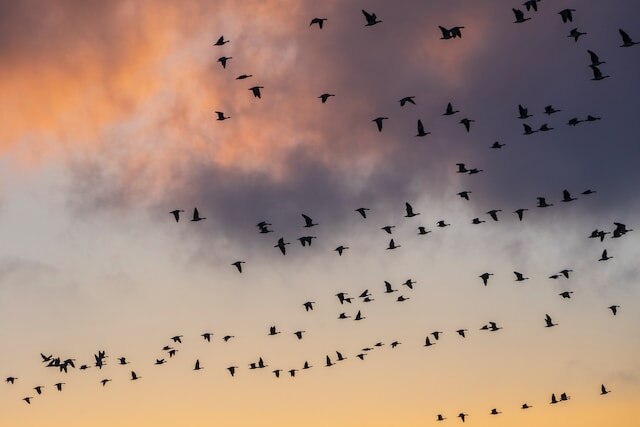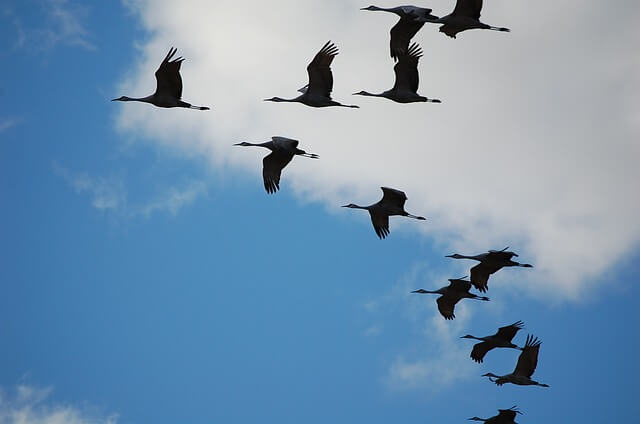Let’s go on a journey into the world of bird migration! Have you ever thought about why birds fly so far each year? Well, let’s find out together. We’ll explore how they find their way, why they travel, and the exciting adventures they have. Get ready to be amazed by the fascinating lives of our feathered friends!
Table of Contents
- 1 Why Do Birds Migrate?
- 2 Bird Migration Patterns
- 3 Reasons for Bird Migration
- 4 Bird Migration Behavior
- 5 Bird Migration Adaptation
- 6 Environmental Factors
- 7 Navigation and Orientation
- 8 Long-Distance Migration
- 9 Bird Migration Patterns: An Overview of Short-Distance Migration
- 10 Conclusion
- 11 FAQs About Bird Migration
- 11.1 What are bird migration patterns?
- 11.2 What are the reasons behind bird migration?
- 11.3 How do birds behave during migration?
- 11.4 What adaptations do birds have for migration?
- 11.5 How do environmental factors affect bird migration?
- 11.6 How do birds navigate and orient themselves during migration?
- 11.7 What is long-distance migration?
- 11.8 What is short-distance migration?
- 11.9 What have we learned about bird migration?
- 12 Author
Key Takeaways:
- Bird migration is a fascinating behavior that has intrigued scientists and nature enthusiasts for centuries.
- In this section, we will explore the reasons behind bird migration, including various patterns and routes birds take.
- Understanding bird migration is essential to conserving and preserving these remarkable avian behaviors for generations to come.
Why Do Birds Migrate?
Birds migrate for a variety of reasons, including to find better food sources, to breed in areas with more favorable conditions, to escape harsh weather conditions, and to avoid predators. Many bird species also migrate to take advantage of seasonal changes in daylight and temperature, which can affect their breeding and feeding behaviors.
Some birds migrate short distances, while others travel thousands of miles each year to reach their destination. Overall, migration is a complex and fascinating behavior that allows birds to adapt to changing environmental conditions and ensure their survival.
Bird Migration Patterns
Migration is a crucial part of the life cycle of many bird species. Some birds travel from one side of the globe to the other, while others move only a few miles. A bird’s migration pattern depends on several factors, including breeding location, habitat availability, and food distribution.
Bird Species Migration
Migration varies between species, with some birds migrating individually, while others travel in flocks. Migratory birds are divided into two main categories: neotropical and palearctic. Neotropical migrant birds travel to Central and South America for the winter, while palearctic migrant birds travel to Africa or southern Asia.
Many birds migrate seasonally and adjust their migration patterns throughout the year. Some birds undertake altitudinal and latitudinal movements. Birds that live in mountainous regions, for example, move to lower elevations during the winter months when temperatures are colder and food is harder to find.
Bird Migration Routes
Birds follow specific routes during their migration patterns, taking advantage of various factors such as wind currents, food sources, and geographical features. Specific routes vary based on a bird’s breeding and wintering locations, with many birds traveling along certain flyways.
The four main North American flyways include the Atlantic, Mississippi, Central, and Pacific Flyways. Birds typically follow these routes, with many species traveling enormous distances. For example, the Arctic Tern travels up to 44,000 miles each year, while the Ruby-throated Hummingbird travels over 3,000 miles from their breeding grounds in Canada to their wintering grounds in Central America.
Reasons for Bird Migration
Bird migration is an incredible phenomenon that has fascinated scientists and bird enthusiasts for centuries. While the exact reasons for bird migration remain a topic of ongoing research, several theories have been proposed based on extensive observation and research.
One of the primary reasons for bird migration is access to abundant food sources. As seasons change, food availability also changes, with certain regions becoming more or less productive for birds. By migrating to different regions at different times of the year, birds can take advantage of the best food sources available, ensuring they have enough energy to survive and reproduce.
In addition to food availability, migration also offers birds favorable breeding conditions. Many bird species migrate to breeding grounds where they can mate and raise their young in optimal conditions. These breeding grounds often have fewer predators and better access to food and other resources, allowing birds to maximize their reproductive success.
Another reason for bird migration is escape from harsh climates. As temperatures drop and weather patterns change, certain regions become inhospitable for many bird species. By migrating to warmer and more hospitable regions, birds can avoid harsh winter conditions and ensure their survival.
Interestingly, migration is not a behavior that all bird species engage in. While some birds migrate regularly, others remain in the same region throughout the year, adapting their behavior and physiology to the changing seasons. For migratory species, the timing and distance of migration can also vary depending on various environmental factors, including weather patterns and habitat availability.
Interesting Bird Migration Facts:
- The Arctic Tern holds the record for the longest migration route of any bird species, traveling up to 44,000 miles each year.
- Birds use various navigational cues to guide their migration, including magnetic fields, the position of the sun and stars, and landmarks.
- Some bird species can fly at altitudes of up to 29,000 feet during migration.
- The annual migration of birds is estimated to be one of the largest movements of biomass on the planet, with billions of birds undertaking journeys each year.
Overall, bird migration is a remarkable behavior that continues to intrigue and inspire researchers and bird enthusiasts alike. By understanding the reasons behind bird migration, we can better appreciate the incredible journeys undertaken by these remarkable creatures and work towards protecting and preserving their habitats and migration routes for future generations.
Bird Migration Behavior
Bird migration is one of the most incredible examples of animal behavior, and the strategies birds employ to navigate during these long journeys are nothing short of remarkable. Birds use a variety of cues to guide their migration, including celestial, magnetic, and olfactory cues.
The ability to navigate using celestial cues is particularly intriguing, as birds use the position of the sun, stars, and moon to determine their direction of travel. This ability is especially useful during the day, when birds can use the position of the sun to orient themselves. At night, birds use the position of the stars to guide them, and it is believed they can even sense the polarization of light to navigate accurately in cloudy conditions.
In addition to celestial cues, birds also rely on the Earth’s magnetic field to orient themselves. It is believed that birds have magnetite particles in their beaks, which help them detect the magnetic field and use it to determine their direction of travel.
Another fascinating aspect of bird migration behavior is the role of instinct and learning. Some bird species are born with an innate sense of direction and instinctively know which direction to travel. Other bird species learn their migration routes from their parents or flock mates during their first migration journey, and will follow these established routes in subsequent years.
During migration, birds face a variety of challenges, including finding food and avoiding predators. As such, many bird species employ specific strategies to ensure they reach their destination safely. For example, some bird species will travel in flocks, allowing them to share navigation duties and improve their chances of survival. Other bird species will fly at higher altitudes to avoid obstacles on the ground or take advantage of favorable winds to save energy.
Bird Migration Strategies
Some bird species employ even more complex strategies to ensure a successful migration. For example, the Arctic Tern embarks on the longest migration of any bird species, traveling up to 44,000 miles round-trip between their breeding grounds in the Arctic and their wintering grounds in the Antarctic. To accomplish this incredible feat, Arctic Terns follow a zig-zagging route that takes advantage of prevailing winds and ocean currents, allowing them to conserve energy and minimize the distance they need to travel.
The Bar-tailed Godwit is another bird species known for its impressive migration strategy. This species embarks on a non-stop flight from Alaska to New Zealand, covering a distance of over 7,000 miles without stopping to rest or eat. To accomplish this feat, Bar-tailed Godwits build up a layer of fat before their migration and reduce their digestive organs’ size, allowing them to fly longer distances without stopping to eat or digest food.
In conclusion, bird migration behavior is an incredible example of animal behavior, highlighting the remarkable ways in which birds have adapted to support their migratory lifestyles. Birds use a variety of cues to navigate during migration, including celestial and magnetic cues. Additionally, bird species employ a range of strategies to ensure a successful migration, from flying in flocks to taking advantage of favorable winds and currents. Understanding these behaviors can help us appreciate the incredible complexity and beauty of bird migration and ensure we work towards protecting and preserving these remarkable avian behaviors for generations to come.
Bird Migration Adaptation
Migration is a demanding and energy-intensive period for birds, and many species have developed remarkable adaptations that enable them to undertake these long journeys. One of the most notable adaptations is the ability to store significant amounts of fat, which serves as an energy source during the migration. Some birds can increase their body weight by as much as 50% prior to migration. This adaptation provides a buffer against unpredictable food availability during the journey, ensuring that birds have enough energy to complete their journey.
In addition to physiological adaptations, birds have also developed a range of behavioral adaptations that support their migratory lifestyle. For example, many bird species have learned to fly in formation, with each bird positioning itself at an optimal angle to reduce the energy required for flight. This behavior, known as drafting, enables birds to conserve energy and increase their endurance during long flights.
Birds have also adapted to changes in daylight hours and environmental factors that signal the need to migrate. For example, many species have developed specialized photoreceptors in their eyes that allow them to detect changes in daylight length. This allows them to make the necessary preparations for migration, such as increasing fat stores and developing the necessary muscles for long flights.
Another remarkable adaptation is the ability of some bird species to detect and orient themselves using the earth’s magnetic field. This remarkable sense allows birds to navigate using a unique “compass” that is unaffected by weather or light levels. Some species of birds can even detect subtle variations in the magnetic field, allowing them to pinpoint their location with remarkable accuracy.
Overall, bird migration is a fascinating and remarkable phenomenon, and the adaptations that birds have developed to support their migratory lifestyle are nothing short of amazing. By understanding these adaptations and the factors that drive bird migration, we can work towards protecting and preserving these valuable avian behaviors for future generations.
Environmental Factors
Bird migration routes are largely influenced by environmental factors, which help determine the availability of resources along the way. Climate change, habitat loss, and other human-induced factors can significantly impact migration patterns and routes, making it crucial to prioritize conservation efforts.
As temperatures rise due to global warming, plants and insects that birds rely on for food may emerge earlier or later than expected. This can cause birds to miss out on crucial food sources or arrive at breeding sites when conditions are unsuitable. Additionally, habitat loss can force birds to alter their migration routes, potentially exposing them to unfamiliar environments and predators.
Human activities such as deforestation, land use changes, and pollution can also affect bird migration patterns. The destruction of key habitats, such as wetlands and stopover sites, can disrupt the natural progression of migratory routes and put species at risk of extinction.
By understanding the environmental factors that impact bird migration, we can work towards creating sustainable practices and preserving the natural habitats that birds rely on during their incredible journeys.
The ability of migratory birds to navigate across vast distances is one of the most remarkable aspects of their behavior. They rely on a combination of cues, including celestial navigation, magnetic fields, and landmarks, to find their way.
Celestial navigation involves using the position of the sun, stars, and moon to determine direction and time of day. Migrating birds use this method to navigate during the day and the night.
Another cue that birds use for navigation is the earth’s magnetic field. Studies have shown that birds are able to detect and respond to the variations in the magnetic field to determine their position and direction.
Birds also use visual landmarks, such as rivers, mountains, and coastlines, to navigate. They are able to recognize these features and use them to orient themselves in the right direction.
Finally, some birds have even been found to use smell to navigate. Pigeons, for example, are able to detect atmospheric odors and use them to navigate.
The Role of Instinct and Learning
The ability to navigate and orient oneself during migration is not entirely instinctual. Research has shown that birds rely on a combination of innate abilities and learned behaviors to successfully navigate their journeys.
For example, young birds learn their migration routes from their parents or other experienced birds. They may also learn to recognize landmarks and cues along the way. However, scientists are still trying to understand the extent to which birds rely on innate abilities versus learned behaviors.
Migration Strategies
Birds employ a variety of strategies to help them navigate and cope with the challenges of migration. For example, some species fly in flocks, which can help them conserve energy and provide protection from predators.
Other birds use weather patterns to their advantage, waiting for favorable winds to aid in their journey. Some birds, such as the Arctic Tern, take advantage of the earth’s rotation to travel incredibly long distances with minimal effort.
Overall, the navigation and orientation abilities of migratory birds are truly remarkable. By understanding how birds navigate and cope during migration, we can better appreciate the incredible journeys they undertake each year.
Long-Distance Migration
Long-distance migration is perhaps the most impressive and well-known type of bird migration. It involves birds traveling great distances, often crossing entire continents or even oceans to reach their destinations. The routes taken by species engaging in long-distance migration span thousands of miles, and the journeys can take several weeks to complete.
Birds that engage in long-distance migration typically breed in the northern hemisphere during the summer months and migrate to warmer regions in the south during the winter. This type of migration is often triggered by changes in day length and the availability of food. As temperatures drop and food becomes scarce, birds begin to move towards more hospitable regions.
Long-distance migration patterns vary among bird species, with some following fixed routes and others being more flexible. Some species, such as the Arctic Tern, undertake the longest migration of any bird, flying from the Arctic to the Antarctic and back each year.
The challenges faced by birds engaging in long-distance migration are numerous. These include fatigue, exposure to extreme weather conditions, and the need to find food and water along the way. To overcome these challenges, birds have developed remarkable adaptations, including increased fat stores for energy, physiological adaptations for endurance, and the ability to navigate using celestial cues and magnetic fields.
The study of long-distance migration is essential to our understanding of bird ecology and migration patterns. By tracking migration routes and patterns, researchers can gain insights into the factors that drive bird behavior and the environmental challenges they face. This information is critical for developing conservation strategies to protect these remarkable avian species and their habitats.
Bird Migration Patterns: An Overview of Short-Distance Migration
In contrast to long-distance migration, short-distance migration occurs over shorter distances and typically takes place within a single region or country. Species that engage in short-distance migration may move between habitats within a particular range, such as from breeding to non-breeding grounds or between feeding and roosting sites.
Short-distance migration can have a predictable pattern, with birds following the same routes year after year. For example, many shorebirds travel north to breeding grounds in the Arctic during the spring and return south for the winter. Other birds, such as raptors, may undertake altitudinal migration, moving to higher elevations during the summer and returning to lower elevations during the winter.
Factors that influence the migration patterns of birds include changes in temperature, food availability, and daylight hours. Birds use these cues to determine when to begin migration and where to go, ensuring that they arrive at their destination with optimal conditions for breeding, feeding, and survival.
Seasonal Short-Distance Migration
Many birds engage in seasonal migration over short distances, following a predictable pattern from breeding to non-breeding grounds. For example, the American Goldfinch travels south for the winter, returning north to breed in the spring. Similarly, the Eastern Bluebird may move from breeding grounds in the eastern United States to wintering sites in the southern United States.
Some species of birds engage in altitudinal migration, moving to higher elevations during the summer and descending to lower elevations during the winter. This type of migration is common among raptors, such as the Golden Eagle and the Red-tailed Hawk, which move to higher elevations during the summer to take advantage of abundant food sources, such as small mammals and other birds.
The Role of Short-Distance Migration in Bird Conservation
Short-distance migration is an essential aspect of bird behavior and plays a significant role in bird conservation. By understanding the patterns and routes of short-distance migratory birds, conservationists can develop targeted conservation efforts to protect important habitats and ensure healthy populations of these species.
Many short-distance migratory birds are also threatened by habitat loss and fragmentation, making conservation efforts critical for their survival. By protecting habitats and minimizing human impact on these areas, we can help ensure the survival of these remarkable species.
Summary
Short-distance migration is a fascinating and essential aspect of bird behavior. By following predictable routes and patterns, birds are able to find ideal breeding, feeding, and roosting sites to survive and thrive. Understanding the factors that drive short-distance migration and its importance in bird conservation can help us protect these remarkable species for years to come.
Conclusion
Throughout this article, we have explored the fascinating world of bird migration and uncovered the reasons behind this awe-inspiring behavior. From the various patterns and routes birds take to the underlying reasons for their incredible journeys, bird migration is a complex and remarkable phenomenon.
It is clear that bird migration plays a vital role in the survival and reproductive success of many species. By migrating to access favorable food sources, breeding conditions, and escape harsh climates, birds are able to thrive in a variety of habitats.
Furthermore, we have seen how birds have evolved remarkable adaptations to support their migratory lifestyles, ranging from physical changes to physiological adaptations for endurance. By understanding the factors that drive bird migration, we can work towards protecting and preserving these incredible avian behaviors for generations to come.
However, we must also be aware of the environmental factors that impact bird migration, from habitat loss to climate change. By taking steps towards conservation efforts and minimizing our impact on the natural world, we can help ensure that bird migration continues to awe and inspire us for years to come.
FAQs About Bird Migration
What are bird migration patterns?
Bird migration patterns refer to the routes and movements that bird species undertake during their migratory journeys. These patterns can vary from seasonal migrations to altitudinal and latitudinal movements, depending on the species and their specific needs.
What are the reasons behind bird migration?
Birds migrate to ensure access to abundant food sources, find favorable breeding conditions, and escape unfavorable environments. Migration offers advantages and benefits that allow birds to survive and thrive in different regions throughout the year.
How do birds behave during migration?
Birds exhibit various behaviors during migration, including navigating long distances, using instinct and learning to find their way, and employing strategies to ensure successful migration. They rely on celestial cues, magnetic fields, landmarks, and even smell to guide their journey.
What adaptations do birds have for migration?
Birds have developed remarkable adaptations for migration, including increased fat stores for energy, physiological changes that support endurance, and behavioral adjustments to optimize their migratory lifestyle. These adaptations help them cope with the demands of long-distance journeys.
How do environmental factors affect bird migration?
Environmental factors such as climate change, habitat loss, and human-induced disruptions can impact bird migration routes and patterns. Changes in weather patterns and the availability of resources can influence when and where birds migrate, highlighting the need for conservation efforts.
Migrating birds use a variety of cues to navigate and orient themselves, including celestial cues such as the position of the sun and stars, magnetic fields, landmarks, and even their sense of smell. These abilities enable them to find their way across vast distances.
What is long-distance migration?
Long-distance migration refers to the incredible journeys undertaken by birds over thousands of miles. Birds engaging in long-distance migration face numerous challenges, such as crossing geographical barriers and navigating through different habitats, but they persist to reach their desired destinations.
What is short-distance migration?
Short-distance migration involves the movement of birds over shorter distances, typically within a region or between nearby habitats. Species engaging in short-distance migration may exhibit different behaviors and triggers for their movements compared to long-distance migratory birds.
What have we learned about bird migration?
Through exploring bird migration, we have uncovered the mystery behind their incredible journeys. From understanding migration patterns and reasons to the behavioral adaptations and navigation abilities of birds, it is evident that bird migration is a complex and awe-inspiring phenomenon.


